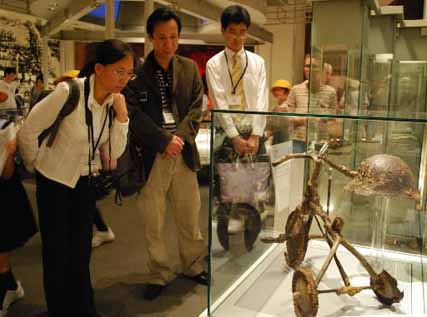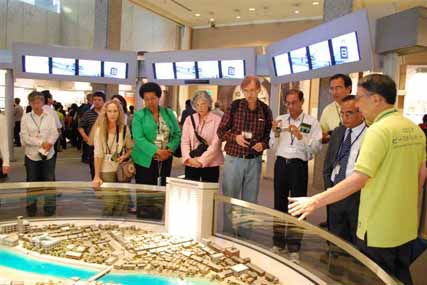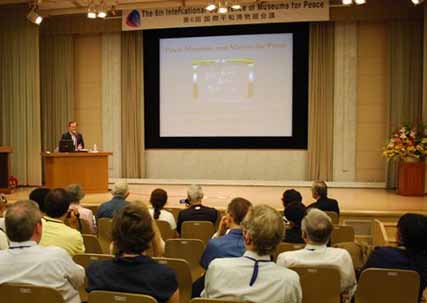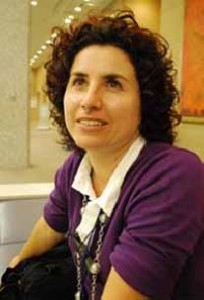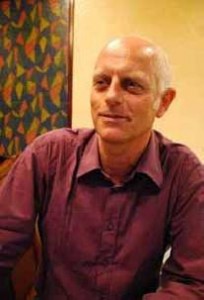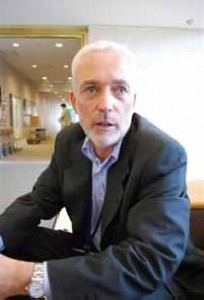Conference participants offer suggestions on renovation of Peace Memorial Museum
Oct. 24, 2008
by Miho Kuwajima, Staff Writer
The 6th International Conference of Museums for Peace was held in early October in Kyoto and Hiroshima. It was attended by peace museum officials, researchers, and representatives of non-governmental organizations in 24 countries and regions in Asia, Europe, North America, South America, and Africa. In Hiroshima, participants discussed various topics including the role of peace museums in the abolition of nuclear weapons. Since it opened in 1955, Hiroshima Peace Memorial Museum, where the conference was held, has attempted to convey through its exhibits the horror of the atomic bombing and Hiroshima’s hope for the abolition of nuclear weapons. Fourteen years have passed since the museum’s renovation in 1994 and changes to its exhibits are under consideration. Conference participants from both Japan and abroad were offered suggestions on how the museum should convey its message in the future.
At the start of his keynote speech on October 10, the final day of the conference, Hiroshima Mayor Tadatoshi Akiba spoke about some of the issues facing the museum. One concern involves the number of exhibits that lead up to those showing the devastation caused by the bombing. Due to a large number of displays, visitors are worn out by the time they arrive at the heart of the museum. Another is that the exhibits end abruptly and there is nowhere for visitors to pause to reflect on what they have seen.
The city began reviewing the museum’s exhibitions in 2004 in anticipation of the 60th anniversary of the bombing. After numerous discussions with university professors, atomic bomb survivors, and others, in April the city began fleshing out a renovation plan that was drafted last fiscal year.
Issues that have been discussed thus far include: 1) changing the order in which the exhibits are viewed to start with the devastation caused by the bombing rather than the background behind Hiroshima’s military facilities and the development of the atomic bomb and an explanation of the nuclear age, 2) creating a space at the end of the exhibits in which visitors can reflect on what they have seen, 3) creating exhibits that will allow visitors to relate more fully to the experiences of each atomic bomb survivor.
With regard to the city’s plan to create a space where visitors can reflect on what they have seen, Nitza Milagros Escalera, 56, a lecturer at Fordham University in New York, suggested creating an area where families and friends can draw pictures or write poems together. She also suggested having a staff member on hand to listen to visitors’ impressions and to talk with them. She said she was shocked by what she saw during her first visit to the museum and felt that just writing something down by herself was not enough.
Erik Somers, 50, director of exhibitions for the Netherlands State Institute for War Documentation, felt, along with other conference participants, that the museum was too big and had too many panels offering detailed information lining the walls.
Mr. Somers indicated that even if the exhibits provide extensive details on the power of the atomic bomb, the number of deaths, and other facts, visitors won’t remember them. Along with items that belonged to victims of the bombing, he proposed having exhibits that describe how the families that donated those items to the museum got through the war and the postwar years. This kind of exhibit would appeal to people’s emotions and reinforce their feelings about the importance of peace, he said.
Kim Yeong Hwan, 36, of the Center for Peace Museum in Seoul, said the museum should also feature exhibits that focus on atomic bomb survivors living outside Japan, including those in South Korea. He said that in Korea it is widely believed that the atomic bombing of Japan led to Korea’s liberation, and many people have little interest in the issue of nuclear weapons.
He suggested that if Koreans thought about the inhumanity of the atomic bomb through the lives of survivors living outside Japan, the level of interest in the issue of nuclear weapons in Korea would be equal to that of Japan. He expressed the hope that the newly renovated museum will fulfill this role.
Peter van den Dungen, 60, of the Department of Peace Studies at the University of Bradford in England, said he would like the museum to take on a more active role and not only convey the historical facts of the bombing but also motivate the people of the world to abolish nuclear weapons.
Mr. Van den Dungen, who first proposed a conference of museums for peace in 1992, was a panelist in a symposium held on October 10. He said the unique feature of Japan’s peace museums is the way in which they pass on memories of the war through the belongings of victims and the stories of survivors and promote an anti-war, pro-peace mentality. He said Hiroshima’s Peace Museum seems limited by that framework.
Mr. Van den Dungen said the museum needs something that will inspire travelers who stop in and who are not particularly interested in nuclear issues to take some kind of action to abolish nuclear weapons and to build peace. He said he would like to see the expansion of the area in which the global nuclear situation is explained, especially in ways that children can understand, and in which the activities of citizens in Hiroshima and other regions are described.
Through her work as coordinator at the Disarmament & Security Centre of the World Court Project, a New Zealand NGO, Kate Dewes, 55, was involved in getting the International Court of Justice to issue an advisory opinion stating that the threat and use of nuclear weapons is a violation of international law. She suggested that one way to display the information on the current situation regarding nuclear weapons would be to make use of materials that have been produced by the Japanese news media, which have covered the atomic bombings, nuclear testing, and other issues.
She proposed showing a documentary on the ambiguous stance the Japanese government has taken toward the ICJ advisory opinion as well as a special program on the survivors of nuclear tests conducted on the Marshall Islands. Ms. Dewes said that in order to motivate young people, their awareness of the issues must first be raised, and she stressed that Peace Memorial Museum should be able to provide that motivation.
More than 60 years have passed since the end of World War II. If the museum’s exhibitions are not presented in a manner appropriate to the times they will have less impact on visitors. It is imperative to present the experiences and thoughts of the A-bomb survivors and those involved in the rebuilding of Hiroshima in such a way that visitors can clearly imagine them.
The number of visitors from overseas is increasing year by year, and last fiscal year the Peace Memorial Museum attracted a record 174,815 visitors. It is hoped the museum will not only promote the need for the abolition of nuclear weapons but serve, too, as an inspiration for the people of the world to make efforts for peace.
Three examples of renovation from Europe
Based on a subcommittee report, the following is a description of changes that peace museums in Europe made to their initial concepts.
Iratxe Momoitio Astorkia, 36, director of the Gernika Peace Museum in Spain
Display items kept to a minimum
When it opened 10 years ago, the museum focused on the historical facts surrounding the Spanish Civil War (1936-39) and the 1937 bombing of Guernica. While retaining its original focus on Guernica’s experience, five years ago the museum was reopened as a peace museum featuring exhibits on the history of the war and the concept of peace.
Our aim was to have visitors not only learn about the past but also to give them an opportunity to address the issue of peace. In order to create a space with an emotional impact, the number of items on display was kept to a minimum.
There is also a permanent exhibition on the Basque conflict, which has been going on for more than 30 years. It is an issue that is difficult to discuss at school or in the home, but we feel it is our responsibility to look at the underlying causes of this regional conflict and to seek a path toward its resolution.
Erik Somers, 50, director of exhibitions for the Netherlands State Institute for War Documentation
Viewpoint of children incorporated
Although few battles were fought there, we have 15 peace museums in the Netherlands because 70 percent of the Jewish population was exterminated by the Nazis. All of the museums stress the victimization of the Jews by the Nazis and present those who resisted the Nazis as heroes.
In the latter half of the 1990s we began changing the way in which items are displayed. The clothing and toys of people who were children during the war are displayed along with accounts of their recollections in a display that focuses on children in wartime. We asked various people to describe their experiences--not only family members of Jews who were exterminated but also those whose parents were Nazis. As the number of immigrants to the Netherlands increases, we must do something to see that children think of war as an issue that directly affects them.
Roger Mayou, 54, director of the International Red Cross and Red Crescent Museum in Switzerland
Societal changes to be addressed
The museum’s displays focus on humanitarian aid, which is the primary mission of the Red Cross. In conjunction with this year’s 20th anniversary of the museum’s opening, we are preparing to completely renovate the facility.
The environment in which we get information has changed tremendously in the last 20 years, and it is difficult to convey subjects adequately just by presenting information in chronological order.
In the new museum we plan to make the first half an area that will appeal to people’s emotions while the second half will offer commentary on history and provide information. We are going to create a room in which we address issues facing today’s ever-changing society, and we also plan to have a room where people can consider the importance of peace and helping others from the standpoint of families, something everyone is familiar with.
(Originally published on October 20, 2008)
Related articles
International Conference of Museums for Peace held in Kyoto and Hiroshima (Oct. 8, 2008)
Peace Museums of the World: Hiroshima Peace Memorial Museum, Japan (Jan. 25, 2008)
The 6th International Conference of Museums for Peace was held in early October in Kyoto and Hiroshima. It was attended by peace museum officials, researchers, and representatives of non-governmental organizations in 24 countries and regions in Asia, Europe, North America, South America, and Africa. In Hiroshima, participants discussed various topics including the role of peace museums in the abolition of nuclear weapons. Since it opened in 1955, Hiroshima Peace Memorial Museum, where the conference was held, has attempted to convey through its exhibits the horror of the atomic bombing and Hiroshima’s hope for the abolition of nuclear weapons. Fourteen years have passed since the museum’s renovation in 1994 and changes to its exhibits are under consideration. Conference participants from both Japan and abroad were offered suggestions on how the museum should convey its message in the future.
At the start of his keynote speech on October 10, the final day of the conference, Hiroshima Mayor Tadatoshi Akiba spoke about some of the issues facing the museum. One concern involves the number of exhibits that lead up to those showing the devastation caused by the bombing. Due to a large number of displays, visitors are worn out by the time they arrive at the heart of the museum. Another is that the exhibits end abruptly and there is nowhere for visitors to pause to reflect on what they have seen.
The city began reviewing the museum’s exhibitions in 2004 in anticipation of the 60th anniversary of the bombing. After numerous discussions with university professors, atomic bomb survivors, and others, in April the city began fleshing out a renovation plan that was drafted last fiscal year.
Issues that have been discussed thus far include: 1) changing the order in which the exhibits are viewed to start with the devastation caused by the bombing rather than the background behind Hiroshima’s military facilities and the development of the atomic bomb and an explanation of the nuclear age, 2) creating a space at the end of the exhibits in which visitors can reflect on what they have seen, 3) creating exhibits that will allow visitors to relate more fully to the experiences of each atomic bomb survivor.
With regard to the city’s plan to create a space where visitors can reflect on what they have seen, Nitza Milagros Escalera, 56, a lecturer at Fordham University in New York, suggested creating an area where families and friends can draw pictures or write poems together. She also suggested having a staff member on hand to listen to visitors’ impressions and to talk with them. She said she was shocked by what she saw during her first visit to the museum and felt that just writing something down by herself was not enough.
Erik Somers, 50, director of exhibitions for the Netherlands State Institute for War Documentation, felt, along with other conference participants, that the museum was too big and had too many panels offering detailed information lining the walls.
Mr. Somers indicated that even if the exhibits provide extensive details on the power of the atomic bomb, the number of deaths, and other facts, visitors won’t remember them. Along with items that belonged to victims of the bombing, he proposed having exhibits that describe how the families that donated those items to the museum got through the war and the postwar years. This kind of exhibit would appeal to people’s emotions and reinforce their feelings about the importance of peace, he said.
Kim Yeong Hwan, 36, of the Center for Peace Museum in Seoul, said the museum should also feature exhibits that focus on atomic bomb survivors living outside Japan, including those in South Korea. He said that in Korea it is widely believed that the atomic bombing of Japan led to Korea’s liberation, and many people have little interest in the issue of nuclear weapons.
He suggested that if Koreans thought about the inhumanity of the atomic bomb through the lives of survivors living outside Japan, the level of interest in the issue of nuclear weapons in Korea would be equal to that of Japan. He expressed the hope that the newly renovated museum will fulfill this role.
Peter van den Dungen, 60, of the Department of Peace Studies at the University of Bradford in England, said he would like the museum to take on a more active role and not only convey the historical facts of the bombing but also motivate the people of the world to abolish nuclear weapons.
Mr. Van den Dungen, who first proposed a conference of museums for peace in 1992, was a panelist in a symposium held on October 10. He said the unique feature of Japan’s peace museums is the way in which they pass on memories of the war through the belongings of victims and the stories of survivors and promote an anti-war, pro-peace mentality. He said Hiroshima’s Peace Museum seems limited by that framework.
Mr. Van den Dungen said the museum needs something that will inspire travelers who stop in and who are not particularly interested in nuclear issues to take some kind of action to abolish nuclear weapons and to build peace. He said he would like to see the expansion of the area in which the global nuclear situation is explained, especially in ways that children can understand, and in which the activities of citizens in Hiroshima and other regions are described.
Through her work as coordinator at the Disarmament & Security Centre of the World Court Project, a New Zealand NGO, Kate Dewes, 55, was involved in getting the International Court of Justice to issue an advisory opinion stating that the threat and use of nuclear weapons is a violation of international law. She suggested that one way to display the information on the current situation regarding nuclear weapons would be to make use of materials that have been produced by the Japanese news media, which have covered the atomic bombings, nuclear testing, and other issues.
She proposed showing a documentary on the ambiguous stance the Japanese government has taken toward the ICJ advisory opinion as well as a special program on the survivors of nuclear tests conducted on the Marshall Islands. Ms. Dewes said that in order to motivate young people, their awareness of the issues must first be raised, and she stressed that Peace Memorial Museum should be able to provide that motivation.
More than 60 years have passed since the end of World War II. If the museum’s exhibitions are not presented in a manner appropriate to the times they will have less impact on visitors. It is imperative to present the experiences and thoughts of the A-bomb survivors and those involved in the rebuilding of Hiroshima in such a way that visitors can clearly imagine them.
The number of visitors from overseas is increasing year by year, and last fiscal year the Peace Memorial Museum attracted a record 174,815 visitors. It is hoped the museum will not only promote the need for the abolition of nuclear weapons but serve, too, as an inspiration for the people of the world to make efforts for peace.
Three examples of renovation from Europe
Based on a subcommittee report, the following is a description of changes that peace museums in Europe made to their initial concepts.
Iratxe Momoitio Astorkia, 36, director of the Gernika Peace Museum in Spain
Display items kept to a minimum
When it opened 10 years ago, the museum focused on the historical facts surrounding the Spanish Civil War (1936-39) and the 1937 bombing of Guernica. While retaining its original focus on Guernica’s experience, five years ago the museum was reopened as a peace museum featuring exhibits on the history of the war and the concept of peace.
Our aim was to have visitors not only learn about the past but also to give them an opportunity to address the issue of peace. In order to create a space with an emotional impact, the number of items on display was kept to a minimum.
There is also a permanent exhibition on the Basque conflict, which has been going on for more than 30 years. It is an issue that is difficult to discuss at school or in the home, but we feel it is our responsibility to look at the underlying causes of this regional conflict and to seek a path toward its resolution.
Erik Somers, 50, director of exhibitions for the Netherlands State Institute for War Documentation
Viewpoint of children incorporated
Although few battles were fought there, we have 15 peace museums in the Netherlands because 70 percent of the Jewish population was exterminated by the Nazis. All of the museums stress the victimization of the Jews by the Nazis and present those who resisted the Nazis as heroes.
In the latter half of the 1990s we began changing the way in which items are displayed. The clothing and toys of people who were children during the war are displayed along with accounts of their recollections in a display that focuses on children in wartime. We asked various people to describe their experiences--not only family members of Jews who were exterminated but also those whose parents were Nazis. As the number of immigrants to the Netherlands increases, we must do something to see that children think of war as an issue that directly affects them.
Roger Mayou, 54, director of the International Red Cross and Red Crescent Museum in Switzerland
Societal changes to be addressed
The museum’s displays focus on humanitarian aid, which is the primary mission of the Red Cross. In conjunction with this year’s 20th anniversary of the museum’s opening, we are preparing to completely renovate the facility.
The environment in which we get information has changed tremendously in the last 20 years, and it is difficult to convey subjects adequately just by presenting information in chronological order.
In the new museum we plan to make the first half an area that will appeal to people’s emotions while the second half will offer commentary on history and provide information. We are going to create a room in which we address issues facing today’s ever-changing society, and we also plan to have a room where people can consider the importance of peace and helping others from the standpoint of families, something everyone is familiar with.
(Originally published on October 20, 2008)
Related articles
International Conference of Museums for Peace held in Kyoto and Hiroshima (Oct. 8, 2008)
Peace Museums of the World: Hiroshima Peace Memorial Museum, Japan (Jan. 25, 2008)

